RESEARCH
Practice audits to reduce caesareans in a tertiary referral hospital in south-western China
Audit de bonnes pratiques pour réduire les césariennes dans un hôpital de troisième ligne en Chine du Sud-ouest
Auditorías de las prácticas para reducir las cesáreas en un hospital de atención terciaria en el suroeste de China
Ma RunmeiI*; Lao Terence TII; Sun YonghuI; Xiao HongI; Tian YuqinI; Li BailuanI; Yang MinghuiI; Yang WeihongI; Liang KunIII; Liang GuohuaI; Li HongyuI; Geng LiI; Ni RenminI; Qi WenjinI; Chen ZhuoI; Du MingyuI; Zhu BeiI; Xu JingI; Tao YanpingI; Zhang LanI; Song XianyanI; Qu ZaiqingI; Sun QianI; Yi XiaoyunI; Yu JihuiI; Zhang DandanI
IDepartment of Obstetrics and Gynaecology, the First Affiliated Hospital of Kunming Medical University, PO Box 650032, No.295 Xi Chang Rd, Kunming, Yunnan Province, China
IIDepartment of Obstetrics and Gynaecology, Chinese University of Hong Kong, Hong Kong Special Administrative Region, China
IIIDepartment of Paediatrics, First Affiliated Hospital of Kunming Medical University, Kunming, China
ABSTRACT
OBJECTIVE: To assess the effectiveness of a three-stage intervention to reduce caesarean deliveries in a Chinese tertiary hospital.
METHODS: A retrospective study was conducted to assess whether educating staff, educating patients and auditing surgeon practices (introduced in 2005) had reduced caesarean delivery rates. Multiple logistic regression was used to check for a potential association between caesarean rates and rates of admission to the neonatal intensive care unit (NICU).
FINDINGS: The caesarean delivery rate ranged from 53.5% to 56.1% in 2001-2004 and from 43.9% to 36.1% in 2005-2011. When 2001-2004 and 2005-2011 were treated as "before" and "after" periods to evaluate the intervention's impact on the mean caesarean section rate, a significant reduction was noted: from 54.8% to 40.3% (odds ratio, OR: 0.56; 95% confidence interval, CI: 0.52-0.59; χ2 test: P < 0.001). The overall drop in the caesarean section rate was significant (χ2 test: P < 0.001) and inversely correlated with the years (Spearman's ρ: -0.096; P < 0.001). Although complicated pregnancies increased after 2004, the primary caesarean section rate decreased annually by 20% on average in 2005-2011, after practice audits were implemented. Multiple logistic regression showed a positive association between the caesarean delivery rate and the rate of admission to the NICU (adjusted OR: 1.26; 95% CI: 1.14-1.40).
CONCLUSION: Patient and staff education and practice audits reduced the Caesarean section rate in a tertiary referral hospital without an increase in admissions to the NICU.
RÉSUMÉ
OBJECTIF: Evaluer l'efficacité d'une intervention en trois étapes pour réduire les accouchements par césarienne dans un hôpital de troisième ligne chinois.
MÉTHODES: Une étude rétrospective a été menée afin de déterminer si l'éducation du personnel, l'éducation des patients et l'audit des pratiques des chirurgiens (introduit en 2005) avaient réduit les taux d'accouchement par césarienne. Une régression logistique multiple a été utilisée pour vérifier une éventuelle corrélation entre les taux de césarienne et les taux d'admission à l'unité de soins intensifs néonataux.
RÉSULTATS: Le taux de césarienne variait de 53,5% à 56,1% en 2001-2004 et de 43,9% à 36,1% en 2005-2011. Lorsque 2001-2004 et 2005-2011 ont été traités en tant que périodes "avant" et "après" pour évaluer l'impact des interventions sur le taux moyen de césarienne, une réduction significative a été mise en évidence: de 54,8% à 40,3% (rapport des chances, OR: 0,56; intervalle de confiance à 95%, IC: 0,52 à 0,59; test de χ2: P <0,001). La baisse globale du taux de césarienne était significative (test de χ2: P <0,001) et inversement corrélée avec les années (ρ de Spearman: -0,096; P <0,001). Bien que les grossesses compliquées aient augmenté après 2004, le taux de césarienne primaire a diminué chaque année de 20% en moyenne en 2005-2011, après que l'audit de bonnes pratiques ait été mis en œuvre. Une régression logistique multiple a montré une corrélation positive entre le taux de naissance par césarienne et le taux d'admission à l'unité de soins intensifs néonataux (OR ajusté: 1,26, IC 95%: 1,14 à 1,40).
CONCLUSION: L'éducation des patients et du personnel ainsi que l'audit de bonnes pratiques ont réduit le taux de césarienne dans un hôpital de troisième ligne, sans augmentation des admissions en soins intensifs néonataux.
RESUMEN
OBJETIVO: Evaluar la eficacia de una intervención en tres etapas para reducir los partos por cesárea en un hospital de atención terciaria en China.
MÉTODOS: Se realizó un estudio retrospectivo para evaluar si el programa educativo para el personal y los pacientes y la auditoría de las prácticas de los cirujanos (que se pusieron en marcha en el año 2005) habían disminuido la tasa de partos por cesárea. Se empleó una regresión logística múltiple para comprobar la posible relación entre la tasa de cesáreas y la tasa de admisión en la unidad de cuidados intensivos neonatales (UCIN).
RESULTADOS: La tasa de partos por cesárea osciló entre el 53,5% y el 56,1% entre 2001 y 2004 y entre el 43,9% y el 36,1% entre 2005 y 2011. Se constata una reducción significativa en la misma si se consideran los años 2001-2004 y 2005-2011 como periodos «antes» y «después» para evaluar el impacto de la intervención sobre la tasa media de partos por cesárea: del 54,8% al 40,3% (razón de posibilidades, OR: 0,56; intervalo de confianza, IC, del 95%: 0,54 - 0,59; χ2test P<0,001). La disminución general en la proporción de cesáreas fue significativa (χ2 test: P<0,001) y estuvo relacionada de forma inversa con los años (correlación de Spearman ρ: -0,096; P<0,001). A pesar del aumento de embarazos complicados después de 2004, la tasa de cesáreas primarias disminuyó anualmente hasta un 20% de media entre los años 2005-2011 después de haber puesto en marcha las auditorías de las prácticas. La regresión logística múltiple mostró una relación positiva entre la tasa de partos por cesárea y la tasa de admisión en la unidad de cuidados intensivos neonatales UCIN (OR ajustada: 1,26; IC del 95%: 1,14-1,40).
CONCLUSIÓN: El programa educativo para el personal y los pacientes, así como las auditorías de las prácticas redujeron la tasa de cesáreas en un hospital de atención terciaria sin aumentar el número de admisiones en la UCIN.
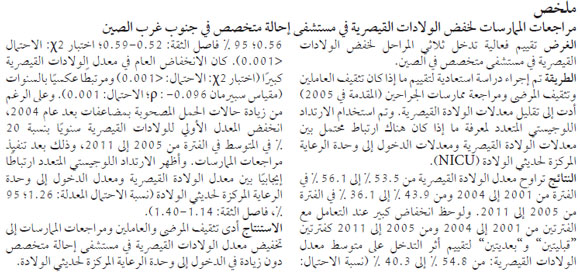

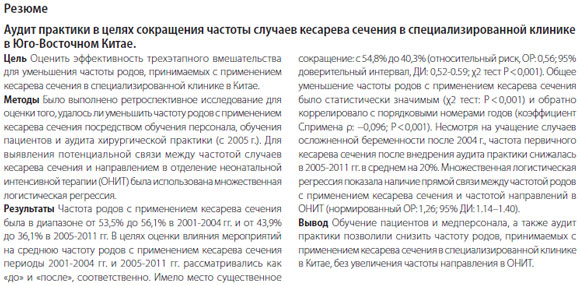
Introduction
Caesarean delivery rates are steadily increasing in many parts of the world. Although caesarean delivery greatly improves obstetric outcomes when clinically indicated, excessively high caesarean delivery rates have raised concern about the health and economic consequences of this practice.1Caesarean delivery has been shown to substantially increase the risk of maternal and perinatal morbidity, including bleeding, infection, anaesthetic complications, postpartum thromboembolism and postpartum depression. Maternal mortality among women who undergo caesarean section is four to ten times higher than among women who deliver vaginally, and uterine scarring from a caesarean can undermine reproductive health.2-7
China is among the few countries that have experienced a dramatic increase in caesarean section rates in recent years. The caesarean "culture" in China began in the 1990s and rapidly spread from the wealthier to the poorer segments of society, particularly over the last decade.8-10 In the late 1990s, hospital-based studies in urban China reported caesarean delivery rates ranging from 26% to 63%.11-13 A study conducted from 1993 to 2002 documented an increase in the rate of caesarean delivery from 8.9% to 24.8% in 30 selected counties in three Chinese regions.9 Similarly, data from three nationwide household health surveys in urban cities showed a rise in the caesarean section rate from 18.2% in 1990-1992 to 39.5% in 1998-2002.14 According to the most recent study from south-eastern China, the overall rate of caesarean delivery increased from 22% in 1994 to 60% in 2003 and stabilized at 56% in 2006. The leading contributor to this increase was found to be maternal request.8 Recent figures show rates as high as 70% and 77.7% in some rural areas and in Changsha, a city in south-central China.7,15Indeed, a World Health Organization (WHO) survey that explored the different delivery methods in nine Asian countries, including China, in 2007-2008 showed that China's average annual caesarean delivery rate of 46.2% was the highest.16
The factors that explain China's exceedingly high caesarean delivery rate are complex and have less to do with medical than with social determinants,8,17which are influenced, in turn, by the country's one-child-per-family policy. Nevertheless, while the persistently elevated rates of caesarean delivery have drawn widespread public attention within China, no efforts to reduce them have ever been reported, perhaps because the results of non-clinical interventions targeting pregnant women and health-care professionals have been suboptimal in other settings.18,19
Our institution, the First Affiliated Hospital of Kunming Medical University, is located in the province of Yunnan in south-western China. The province is similar to Malaysia in size but its population is almost double that of Malaysia. We introduced administrative control measures in 2005 because the caesarean delivery rate in our hospital was increasing at an alarming rate in the early 2000s. We subsequently reviewed our obstetric data from 2001 to 2011 to assess the effectiveness of our intervention in reducing the caesarean delivery rate and to investigate if any parallel change in the rate of admissions to the neonatal intensive care unit (NICU) had occurred. Our study and its findings are presented in this paper.
Methods
Study design and data sources
We conducted a retrospective cohort study of all deliveries that were attended at The First Affiliated Hospital of Kunming Medical University from January 2005 to December 2011. This is a teaching hospital and the main regional referral centre for high-risk pregnancies in Yunnan province. Most of our patients have medical insurance. In response to the institution's rapidly increasing rate of caesarean sections, beginning in January 2005 certain measures were introduced under a continuous quality improvement programme in three sequential stages (stage 1: January 2005 to December 2006; stage 2: January to June 2007; stage 3: January 2005 to December 2011.).
In stage 1 we implemented an educational programme for the staff, and the entire obstetrics department eventually reached the consensus that every obstetrician had to bear the responsibility for avoiding unnecessary caesarean sections. At the same time, unnecessary caesareans were discouraged by: (i) depriving surgeons of potential financial incentives for practising caesareans; (ii) reviewing the indications for the caesarean deliveries performed every day; (iii) implementing international guidelines on caesarean delivery (e.g. those of the American or the Royal College of Obstetricians and Gynaecologists), and (iv) improving labour monitoring and assessment. The staff was primed to be always ready for any expected and unexpected emergency events during vaginal birth. We actively promoted public health education on the advantages of natural delivery and the risks associated with caesarean section among our pregnant patients, both through antenatal school and the public media. For referred patients or those who did not attend antenatal education, the educational programme was delivered after admission in birth preparation classes or in pre-delivery discussions on mode of delivery to ensure that every patient was exposed to the antenatal educational materials. We classified as unnecessary any caesarean section that was performed without an indication or risk factor appearing in the medical record.20 Patients who insisted on having caesarean delivery without a medical indication have to sign a special consent form that clearly delineates for them and their family members the risks and potential complications associated with caesarean section. The patients are also required to record their reasons for wanting to deliver by caesarean. Through these measures we ensure that patients who have requested a caesarean section have had a chance to consider their options in an informed way. This approach has often resulted in patients changing their minds and requesting a vaginal birth instead of a caesarean section. All mothers who were at least 28 weeks pregnant and who were preparing to deliver a liveborn infant participated in the educational programme, or stage 1 of our intervention.
In stage 2 we introduced a category for risk-adjusted caesarean rates in our institutional statistics, since it is very difficult to set a cut-off for the ideal caesarean section rate. Because the ideal rate depends to a large extent on the case mix and type of hospital (i.e. basic or referral hospital), in some countries a risk-adjusted rate has been recommended as an indicator of the quality of obstetric care in a given population or hospital.21 By adjusting the caesarean section rate for the rates of maternal and fetal risk factors present before labour, it becomes possible to attribute changes in obstetric outcomes to changes in the quality of care rather than to patient mix, a potential confounder.22 A caesarean section rate that is above or below the expected or risk-adjusted rate for a given hospital has been associated with increased maternal and perinatal morbidity.22 In 2007 we investigated the risk factors for caesarean delivery using a logistic regression model and compared risk-adjusted primary caesarean delivery rates with the observed primary caesarean delivery rates. We interpreted the difference between the observed and the risk-adjusted rate as an indicator of the quality of obstetric care. Our findings were presented at the 2007 China National Perinatal Congress.23
In stage 3 of our intervention, which lasted from 2005 to 2011, we assessed whether changes in the caesarean delivery rate had affected neonatal outcomes. This was done in response to claims from other centres that their higher caesarean delivery rates reflected efforts on their part to optimize perinatal outcomes. We obtained data on basic delivery information, perinatal outcomes and neonatal morbidity (e.g. birth asphyxia, injuries, jaundice, hypoglycaemia, sepsis) from the birth registry, and we reviewed all admissions to the neonatal intensive care unit (NICU) for treatment (rather than observation) during 2005-2011. This review, which was approved by the institutional review board, covered all seven years from 2005 to 2011 and involved 20 181 live births at least 28 weeks of gestation in age.
To assess the effectiveness of our intervention, we compared caesarean delivery rates in 2001-2004 with rates in 2005-2011. We also examined the reasons for obstetric referrals and the incidence of complicated pregnancies in 2005-2011 to determine if these had changed with respect to 2001-2004 and to rule out case mix as the source of any changes observed in the caesarean section rates. The management protocols for obstetric complications suffered no changes in 2001-2011, and every single live birth in the hospital had been recorded in the hospital's annual statistical database.
Statistical analysis
We used Wald's χ2 test to compare annual caesarean section rates and the annual incidences of common obstetric complications (Table 1) between 2005 and 2011, and we employed Spearman's correlation to measure their potential correlation with year. We performed logistic regression analysis to examine the independent maternal and neonatal risk factors for admission to the NICU for treatment, which we used as a proxy for perinatal morbidity. Neonatal variables included in the regression were birth weight (< 2500 g, 2500-3500 g or > 3500 g); preterm delivery (gestational age < 37 weeks), birth asphyxia (Apgar score < 7 at 5 minutes), multiple gestation and sex. Statistical analysis was performed using SPSS version 17.0 (SPSS Inc., Chicago, United States of America).
Results
A total of 25 280 births fulfilling study criteria occurred during 2001-2011, and the rates of caesarean and vaginal delivery are shown in Table 2 . Overall, the difference in caesarean delivery rates between successive years was significant (P < 0.001) and the rate and year were inversely correlated (P < 0.001). Before intervention measures were introduced in 2001-2004, caesarean delivery rates fluctuated little, from 53.5% to 56.1% (P = 0.68) and did not correlate (P = 0.59) with the years. Beginning in 2005, the annual caesarean delivery rate dropped significantly, from 42.4% in 2005 to 36.1% in 2011 (P < 0.001), and began showing an inverse correlation with advancing years (P = 0.001). Overall, the average caesarean section rate in 2005-2011 was significantly lower than in 2001-2004 (40.3% versus 54.8%; P < 0.001; odds ratio, OR: 0.56; 95% confidence interval, CI: 0.52-0.59).
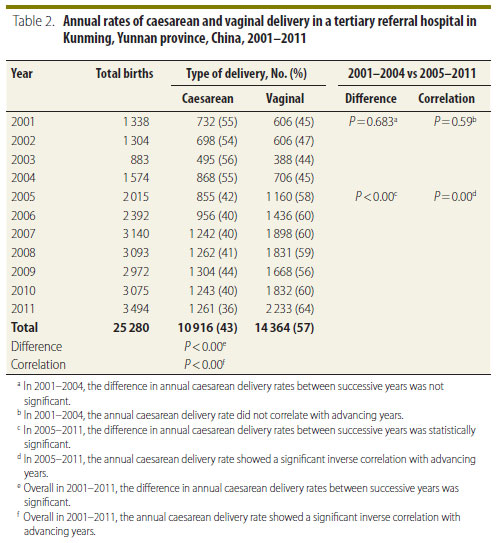
The rates of primary and repeat caesarean are shown in Fig. 1 , together with the incidence of birth asphyxia. The primary caesarean delivery rate decreased by an annual average of 20% after we implemented the third stage of labour control measures, whereas the rate of repeat caesareans increased proportionately, from 1.6% in 2001 to 6.0% in 2011 (P < 0.001). On the other hand, the incidence of birth asphyxia did not increase after 2004 (P = 0.303). Hence, the reduction in the rate of all caesarean deliveries and especially of primary caesareans was not achieved at the cost of increased birth asphyxia.
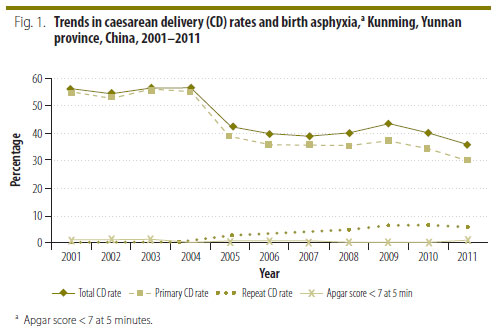
We found a significant increase in the incidence of all obstetric complications, with the exception of placental abruption, after 2004, and the incidence of obstetric complications correlated positively with advancing years (Table 1). The difference between the actual rates of primary caesarean delivery and the risk-adjusted rates (58.9% to 35.4% in 2003-2007, as reported previously23 ) became progressively smaller over time.
Finally, the maternal complications and neonatal risk factors that showed a significant association with admissions to the NICU for treatment were preterm birth; heart disease; diabetes mellitus complicated pregnancy (gestational and pre-gestational); pre-eclampsia; premature rupture of membranes (at term); preterm premature rupture of membranes; severe liver disease; multiple gestation and low birth weight (< 2500 g); Apgar score < 7 at 5 minutes; and male infant sex. However, caesarean delivery was actually associated with increased risk of NICU admission for treatment (Table 3).
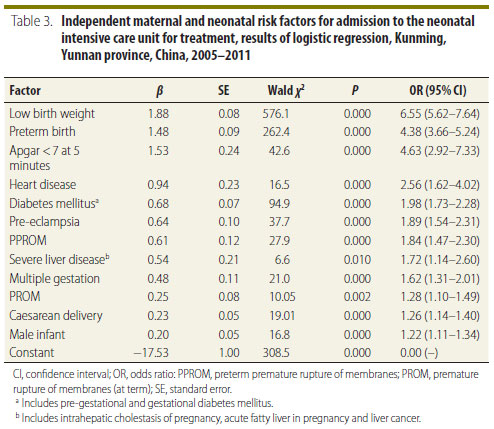
Discussion
While the rates of caesarean section have been steadily increasing in both developed and developing countries,16,24 few countries have experienced rates as high as China.7,8,16 Furthermore, the epidemic of caesarean deliveries in urban areas is likely to extend to rural China as well.15 The impact of this trend on resource-poor Chinese communities cannot be underestimated.
In developed countries and some developing regions, various measures have been implemented to try to reduce caesarean deliveries. These include the dissemination of guidelines, with endorsement and support from local opinion leaders, which offer a trial of labour to women with a previous caesarean; making it mandatory to seek a second opinion and peer review before all potential caesareans and to conduct pre-caesarean consultations and post-caesarean surveillance; and offering nurse-led relaxation and birth preparation classes.18 However, these measures were only marginally successful and their effect was largely confined to intrapartum caesareans and low-risk pregnancies. To the best of our knowledge, no similar efforts to reduce caesarean delivery rates have been made in China, and the intervention described in this paper is the first in the country hospital-initiated and hospital-supported effort aimed at reducing caesareans. The steep rise in the caesarean section rate in our hospital, from 30% in the 1990s to 56.1% in 2004, was consistent with data from the national household survey and population-based surveillance in south-eastern China.8,9 Following the measures we introduced in 2005, our primary caesarean section rate dropped by an annual average of 20% from 2005 to 2011, yet the rate of birth asphyxia did not increase despite a progressive rise in the absolute number and proportion of high-risk pregnancies in our institution. In fact, caesarean delivery was shown to be an independent risk factor for admission to the NICU. This suggests that the unrestricted increase in caesarean rates in China is not justifiable on the basis of an increase in high-risk pregnancies or the need to improve perinatal outcomes.
Studies have shown that China's very high rate of caesarean sections is attributable in part to social and cultural factors.1,3 The Chinese medical system is strongly influenced by user preferences, unlike the health systems in developed societies. Because of the one-child policy, health-care providers are under constant threat of legal action if the obstetric outcome is unsatisfactory. China's current provider payment mechanism and its revenue-related bonus systems for doctors also influence the high rate of caesareans.17 Whereas Taiwan, China, has a policy of equalization of fees for vaginal births and caesareans,25 in mainland China caesareans cost twice or three times as much as vaginal deliveries. To try to control delivery expenditures, the government established a "price transparency policy" to force hospitals to disclose their average charges. Unfortunately, this measure did not achieve its goal.26 Professional bodies in China lack the power to ensure best practices; it is up to individual doctors and medical department heads to uphold medical and ethical principles in standard care. Furthermore, until WHO's global survey showed that China had the highest caesarean section rate in the South-East Asia Region, academic groups and professionals had focused primarily on preventing the complications of caesarean section rather than on preventing unnecessary caesareans.16 As Chinese society has become more sophisticated, patients have become increasingly aware of their rights in making medical decisions, including delivery method when giving birth. The perceived "advantages" of caesarean delivery have led to a misguided surge in its popularity that has unfortunately not been countered by publicized professional opinion, since no legal or professional guidelines exist surrounding the right of health-care providers to decline a request for a caesarean that is not medically indicated. The dilemma facing frontline obstetricians extends to administrators, since China lacks a good administrative system for accrediting, and effectively supervising and evaluating, the equality of obstetric care. The complex interaction between all of these factors makes any attempt to reduce unnecessary caesareans difficult. No solution is in sight, since few are inclined to analyse the problem in depth or to seek a solution.
Our hospital, one of the leading national tertiary centres in China and the best referral centre in Yunnan province, had the lowest rates of caesareans of all types and of primary caesareans - 40.3% and 35.4%, respectively - among all tertiary referral centres in China. The dramatic reduction in our primary caesarean section rate between 2001-2004 and 2005-2011, despite a progressive increase in complicated pregnancies has put us on a par with the United States of America, whose average caesarean section rate is 38%.24 Our findings have confirmed the effectiveness of our measures in reducing the caesarean section rate and suggest that further improvements can be achieved.
In conclusion, we have demonstrated the effectiveness of a multi-faceted intervention in reducing China's elevated caesarean section rate. Further research is needed to determine the cost-effectiveness of this approach under a relaxed one-child policy, considering that women with uterine scarring who get pregnant again are at greater risk of maternal morbidity and mortality. 
Acknowledgements
Parts of this study were presented at the 5th Asia Pacific Congress of Maternal Fetal Medicine, Hong Kong Special Administrative Region, China, 5-7 November 2009.
References
1. Petrou S, Henderson J, Glazener C. Economic aspects of cesarean section and alternative modes of delivery. Best Pract Res Clin Obstet Gynaecol 2001;15:145-63. doi:10.1053/beog.2000.0154 PMID:11359320
2. Petitti DB, Cefalo RC, Shapiro S, Whalley P. In-hospital maternal mortality in the United States: time trends and relation to method of delivery. Obstet Gynecol 1982;59:6-12. PMID:7078850
3. Broe S, Khoo SK. How safe is caesarean section in current practice? A survey of mortality and serious morbidity. Aust N Z J Obstet Gynaecol 1989;29:93-8. doi:10.1111/j.1479-828X.1989.tb01694.x PMID:2803134
4. Levine EM, Ghai V, Barton JJ, Strom CM. Mode of delivery and risk of respiratory diseases in Newborns. Obstet Gynecol 2001;97:439-42. doi:10.1016/S0029-7844(00)01150-9 PMID:11239653
5. Yang Q, Wen SW, Oppenheimer L, Chen XK, Black D, Gao J et al. Association of caesarean delivery for first birth with placenta praevia and placental abruption in second pregnancy. BJOG 2007;114:609-13. doi:10.1111/j.1471- 0528.2007.01295.x PMID:17355267
6. Onwere C, Gurol-Urganci I, Cromwell DA, Mahmood TA, Templeton A, van der Meulen JH. Maternal morbidity associated with placenta praevia among women who had elective caesarean section. Eur J Obstet Gynecol Reprod Biol 2011;159:62-6. doi:10.1016/j.ejogrb.2011.07.008 PMID:21835537
7. Xie RH, Lei J, Wang S, Xie H, Walker M, Wen SW. Cesarean section and postpartum depression in a cohort of Chinese women with a high cesarean delivery rate. J Womens Health (Larchmt) 2011;20:1881-6. doi:10.1089/jwh.2011.2842 PMID:21877916
8. Zhang J, Liu YH, Meikle S, Zheng JC, Sun WY, Li Z. Cesarean delivery on maternal request in Southeast China. Obstet Gynecol 2008;111:1077-82. doi:10.1097/AOG.0b013e31816e349e PMID:18448738
9. Tang SL, Li XY, Wu ZC. Rising cesarean delivery rate in primiparous women in urban China: evidence from three nationwide household health surveys. Am J Obstet Gynecol 2006;195:1527-32. doi:10.1016/j.ajog.2006.03.044 PMID:16677593
10. Klemetti R, Che X, Gao Y, Raven J, Wu Z, Tang S et al. Cesarean section delivery among primiparous women in rural China: an emerging epidemic. Am J Obstet Gynecol 2010;202:65.e1-6. doi:10.1016/j.ajog.2009.08.02 PMID:19819416
11. Wu WL. Cesarean delivery in Shantou, China: a retrospective analysis of 1922 women. Birth 2000;27:86-90. doi:10.1046/j.1523-536x.2000.00086.x PMID:11251484
12. Lin Y, Wen AM, Zhang XY. Analysis on the 10-year changes of rates and indications of cesarean deliveries. Guangdong Yi Xue 2000;21:477-8.
13. Zhu LP, Zhou BH, Hua JZ. Study on the situation of cesarean-section in Shanghai. Shanghai Yi Xue Jian Yan Za Zhi 1999;22:349-51.
14. Sufang G, Padmadas SS, Fengmin Z, Brown JJ, Stones RW. Delivery settings and caesarean section rates in China. Bull World Health Organ 2007;85:755-62. doi:10.2471/BLT.06.035808 PMID:18038056
15. Huang K, Tao F, Liu L, Wu X. Does delivery mode affect women's postpartum quality of life in rural China? J Clin Nurs Epub2011. 25 Oct doi:10.1111/ j.1365-2702.2011.03941.x PMID:22023714
16. Lumbiganon P, Laopaiboon M, Gülmezoglu AM, Souza JP, Taneepanichskul S, Ruyan P et al. Method of delivery and pregnancy outcomes in Asia: the WHO global survey on maternal and perinatal health 2007-08. Lancet 2010;375:490-9. doi:10.1016/S0140-6736(09)61870-5 PMID:20071021
17. Bogg L, Huang K, Long Q, Shen Y, Hemminki E. Dramatic increase of cesarean deliveries in the midst of health reforms in rural China. Soc Sci Med 2010;70:1544-9. doi:10.1016/j.socscimed.2010.01.026 PMID:20219278
18. Khunpradit S, Tavender E, Lumbiganon P, Laopaiboon M, Wasiak J, Gruen RL. Non-clinical interventions for reducing unnecessary caesarean section (review). In: The Cochrane Library, Issue 6, 2011. Chichester: Wiley.
19. Zhang J, Troendle J, Reddy UM, Laughon SK, Branch DW, Burkman R et al. Contemporary cesarean delivery practice in the United States. Am J Obstet Gynecol 2010;203:326.e1-10. doi:10.1016/j.ajog.2010.06.058 PMID:20708166
20. Koroukian SM, Trisel B, Rimm AA. Estimating the proportion of unnecessary Cesarean sections in Ohio using birth certificate data. J Clin Epidemiol 1998;51:1327-34. Erratum in: J Clin Epidemiol 1999;52:379 doi:10.1016/S0895-4356(98)00125-5 PMID:10086827
21. Srinivas SK, Fager C, Lorch SA. Evaluating risk-adjusted cesarean delivery rate as a measure of obstetric quality. Obstet Gynecol 2010;115:1007-13. doi:10.1097/AOG.0b013e3181d9f4b6 PMID:20410776
22. Bailit JL. Measuring the quality of inpatient obstetrical care. Obstet Gynecol Surv 2007;62:207-13. doi:10.1097/01.ogx.0000256800.21193.ce PMID:17306043
23. Liu M, Ma RM, Chen F, Xiao H, Tian YQ, Li BL et al. Risk-adjusted primary CD rates and quality assessment of obstetric care. Progress Obst Gynecol 2007;16:888-92. Chinese.
24. Barber EL, Lundsberg LS, Belanger K, Christian M. Indications contributing to the increasing cesarean delivery rate. Obstet Gynecol 2011;118:29-38. doi:10.1097/AOG.0b013e31821e5f65 PMID:21646928
25. Lo JC. Financial incentives do not always work-an example of cesarean sections in Taiwan. Health Policy 2008;88:121-9. doi:10.1016/j.healthpol.2008.02.013 PMID:18436331
26. Hong X. Factors related to the high cesarean section rate and their effects on the "price transparency policy" in Beijing, China. Tohoku J Exp Med 2007;212:283-98. doi:10.1620/tjem.212.283 PMID:17592216
Submitted: 14 July 2011
Revised version received: 20 January 2012
Accepted: 23 January 2012
Published online: 13 March 2012
Funding: This project was financially supported by research grant (2009CA006) from the Yunnan Science and Technology Committee, Yunnan Province Government.
Competing interests: None declared.
* Correspondence to Ma Runmei (e-mail: marunmeikmmc@163.com)
